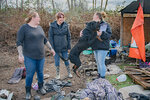
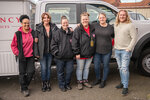
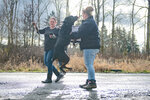

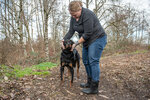

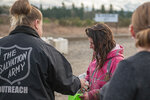


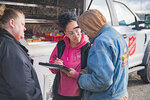

The first encounter occurred while outreach workers were setting up. A young man in his early 30s slowly climbed down an embankment that led up to Interstate 5, with his bike in hand.
“Hey friend, do you want to talk?” an outreach worker called out as the man approached a Salvation Army truck parked on the north end of Blakeslee Junction in Centralia.
While Blakeslee Junction — where a homeless encampment sat on land owned by the Washington State Department of Transportation — was cleared last summer when the land was sold, a few unhoused residents remain on a smaller, privately owned, parcel of land.
As he stood next to the Salvation Army truck, outreach workers gathered basic demographic information, which will help the state determine how to distribute resources.
He was also provided with a drawstring backpack of resources including Spam, fruit cups, cheese, pastries, hand warmers and items and information that could help him receive permanent housing.
“Supplies I feel like, kind of help if you’re offering something beyond help,” outreach worker Carmel Snyder said. “A lot of people are used to hearing, ‘Oh, I can help you’ and not really getting anything out of it.”
The interaction was part of the Salvation Army’s annual Point in Time (PIT) count, which attempts to track the number of “unsheltered homeless” people in Lewis County.
Last week, outreach workers fanned out across Lewis County, from Packwood to Pe Ell, before surveying rural Centralia and Chehalis. A reporter and photographer from The Chronicle joined the Salvation Army Friday.
One of the locations, land on the shores of the Skookumchuck River north of Centralia, showed remnants of a previous encampment. While the site was now vacant, piles of debris and a makeshift shelter still remained.
Other than clothes, water bottles, weathered tarps and several used needles were all that remained at the site. Upon arriving, outreach workers found a timid and skinny rottweiler, though the pup quickly turned rambunctious after a peace offering of dog food. An outreach worker planned to take the dog to a local vet.
Pack said it’s not uncommon for sites to clear, though workers will typically return multiple times to see if they remain vacant.
While not every site was occupied, outreach workers hopped from site to site, looking to establish and expand relationships.
“Today is not about getting a number. It’s not,” Snyder said. “Yes, that’s what we’re supposed to be doing, but that’s not what it’s about. We have to get those connections. If people don’t trust you, they’re not going to engage with you.”
Unsheltered homelessness is defined by the Washington state Department of Commerce as a “person residing in a place not meant for human habitation such as cars, parks, sidewalks, abandoned buildings (on the street).”
Required by law, last year the PIT counted 153 homeless residents in Lewis County, up from 120 in 2022. Numbers for this year will not be available until later this year.
More than 250 community members accessed the Homeless Connect event on Jan. 26, which kicked off the count, though not all were unhoused.
The count is an imperfect measurement — by limitations of identifying everyone in the expansive county who struggles with permanent housing, by the fact that it’s a snapshot in time and may not count those who couch hop or otherwise frequently transition living spaces or by the definition of homelessness.
Those who reside in a makeshift structure may consider it their home, and therefore not self-identify as homeless.
Though the count occurred throughout last week, the Salvation Army is a year-round effort.
“Even though the point in time count is a one-day snapshot,” Salvation Army Centralia Captain Gin Pack said, “it’s actually a year-round conversation.”
While at Blakeslee Junction, outreach workers attempted to contact residents of the makeshift shelters that dot the land, connected with one other resident on the land.
“It’s just relationship building, and being consistent,” Snyder said, adding she has frequently visited Blakeslee Junction to assist.
“At the end of the day, the purpose is about building a connection more than anything.”